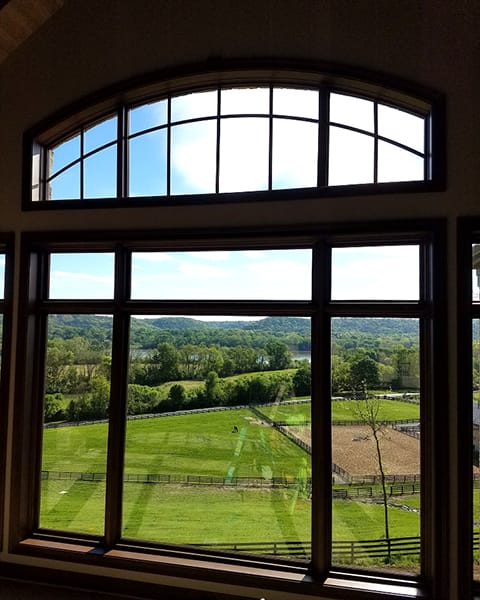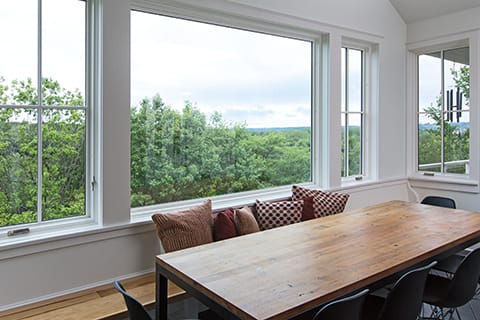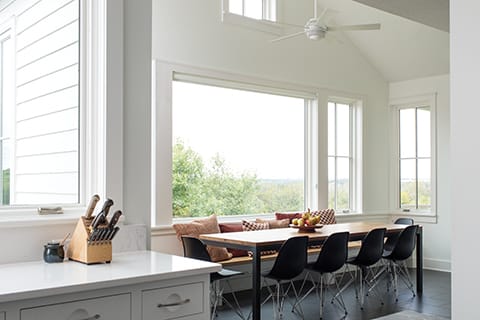What You Need to Know About Picture Windows
Posted
on December 5, 2017

What is a picture window? How are they different from a normal window?
Picture windows are appropriately named, because they are large, fixed panes with low profile frames to maximize your view. Since they’re fixed panes, they are stationary, and can’t move or open.

As you can see in the picture above, picture windows are wide and usually set in the middle, sometimes with other smaller windows on either side. If you have a beautiful exterior view, want to see more of your yard, or want to enhance the lighting or aesthetic of your home, picture windows can be the right solution.
Here’s what you need to know about picture windows and how you can best use them in your home.

Common Configurations with Picture Windows
While picture windows can sometimes be by themselves, they are commonly used in combination with additional windows to create an attractive configuration.
Shawn Huyser, a window expert from the Pella branch in Omaha, had this to say about picture window configurations: “One of our more popular configurations is an XOX, with the center picture window being larger than the two flanker windows.”
The two flanker windows that Huyser is referring to can be a variety of different windows, such as double-hung, sliding, casement or awning. Double-hung picture window combinations are popular with homeowners to add ventilation.
Bay window configurations commonly use a picture window in the center, flanked by venting side panels to expand the view. Bay windows add interest and aesthetic because they extend from the building, giving the illusion of additional space.
Where to Place Picture Windows
Just like there are different configurations of picture windows, there are also different places you could put them. It really depends on your home, your view, and your current windows. With that said, there are a few areas where picture windows work best.
“We often take a two-wide casement window from over the kitchen sink and turn that into an oversized awning with a picture window,” said Huyser. “That really enhances the view from the kitchen, because there isn’t a mull impeding the view any more.”

In addition to the kitchen, Huyser also recommends putting in picture windows in the living room or the master bedroom to enhance lighting and your view.
Picture Window Sizes
Since picture windows can be used around the home in different ways, they are available in a variety of sizes.
If you’re combining double or single-hung windows with a picture window, then a good size range is 28 inches to 36 inches wide and 52 to 74 inches tall.1 If you’re wanting to use casements/awnings with a picture window, then a range of 20 inches to 24 inches wide and 24 inches to 48 inches tall is preferred.1 Large picture windows or fixed frame windows may reach maximum sizes up to 9' 4" x 8' 0" high.
However, picture windows can be custom fit to your needs, so you can have the right configuration for the size and area you have available.
The Advantages of Picture Windows
Picture windows have many advantages, starting with an expansive view. Because they aren’t mulled, they give you an unhindered view of your front, back, or side yard. It’s a great way to show off your landscaping or outdoor scenery. Picture windows also let in lots of natural light, making your room appear brighter and more appealing.
Picture windows also boost your aesthetic appeal, especially if used in a configuration with other windows. It's a great way to get maximum impact from a single window replacement project. Below is a before and after picture of a project that Pella helped with, to turn a sliding door into a picture window to boost the home’s aesthetic and layout.
The Disadvantages of Picture Windows
The most notable disadvantage of picture windows is the lack of ventilation.
Because these large windows are fixed, they are inoperable which means there is no opportunity to open for ventilation or cleaning. Because of this many homeowners choose to place casement, awning, or double-hung windows around their large fixed window. A multiple window configuration not only allows for ventilation, but also adds additional visual interest, creating a wall of windows.
For homeowners looking for a window that can improve their home’s aesthetics, natural light, and expand their view, picture windows are a great option.
Schedule a free consultation to find windows and doors for your home.
